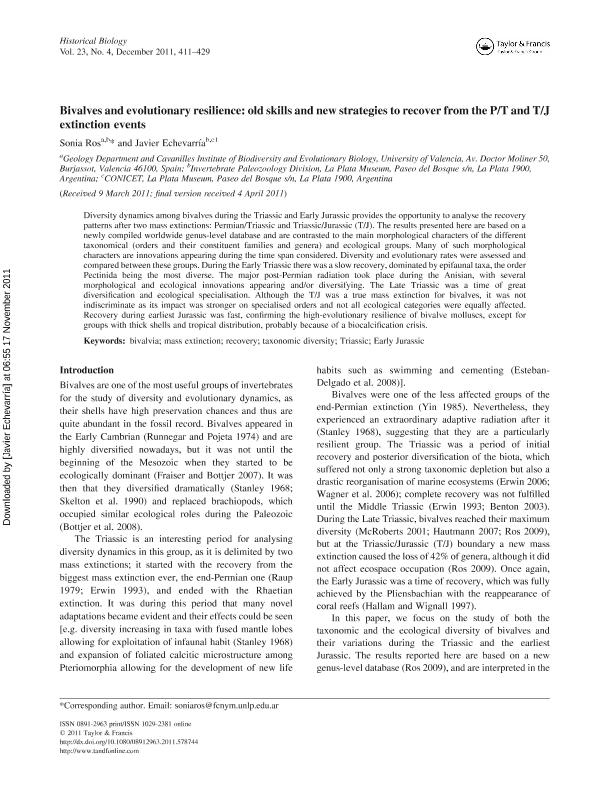Mostrar el registro sencillo del ítem
dc.contributor.author
Ros, Sonia
dc.contributor.author
Echevarría, Javier

dc.date.available
2019-07-16T18:49:37Z
dc.date.issued
2011-12
dc.identifier.citation
Ros, Sonia; Echevarría, Javier; Bivalves and evolutionary resilience: Old skills and new strategies to recover from the P/T and T/J extinction events; Taylor & Francis; Historical Biology; 23; 4; 12-2011; 411-429
dc.identifier.issn
0891-2963
dc.identifier.uri
http://hdl.handle.net/11336/79657
dc.description.abstract
Diversity dynamics among bivalves during the Triassic and Early Jurassic provides the opportunity to analyse the recovery patterns after two mass extinctions: Permian/Triassic and Triassic/Jurassic (T/J). The results presented here are based on a newly compiled worldwide genus-level database and are contrasted to the main morphological characters of the different taxonomical (orders and their constituent families and genera) and ecological groups. Many of such morphological characters are innovations appearing during the time span considered. Diversity and evolutionary rates were assessed and compared between these groups. During the Early Triassic there was a slow recovery, dominated by epifaunal taxa, the order Pectinida being the most diverse. The major post-Permian radiation took place during the Anisian, with several morphological and ecological innovations appearing and/or diversifying. The Late Triassic was a time of great diversification and ecological specialisation. Although the T/J was a true mass extinction for bivalves, it was not indiscriminate as its impact was stronger on specialised orders and not all ecological categories were equally affected. Recovery during earliest Jurassic was fast, confirming the high-evolutionary resilience of bivalve molluscs, except for groups with thick shells and tropical distribution, probably because of a biocalcification crisis.
dc.format
application/pdf
dc.language.iso
eng
dc.publisher
Taylor & Francis

dc.rights
info:eu-repo/semantics/openAccess
dc.rights.uri
https://creativecommons.org/licenses/by-nc-sa/2.5/ar/
dc.subject
Bivalvia
dc.subject
Early Jurassic
dc.subject
Mass Extinction
dc.subject
Recovery
dc.subject
Taxonomic Diversity
dc.subject
Triassic
dc.subject.classification
Paleontología

dc.subject.classification
Ciencias de la Tierra y relacionadas con el Medio Ambiente

dc.subject.classification
CIENCIAS NATURALES Y EXACTAS

dc.title
Bivalves and evolutionary resilience: Old skills and new strategies to recover from the P/T and T/J extinction events
dc.type
info:eu-repo/semantics/article
dc.type
info:ar-repo/semantics/artículo
dc.type
info:eu-repo/semantics/publishedVersion
dc.date.updated
2019-07-04T18:13:07Z
dc.identifier.eissn
1029-2381
dc.journal.volume
23
dc.journal.number
4
dc.journal.pagination
411-429
dc.journal.pais
Reino Unido

dc.journal.ciudad
Londres
dc.description.fil
Fil: Ros, Sonia. Universidad de Valencia; España. Universidad Nacional de La Plata. Facultad de Ciencias Naturales y Museo. División Paleozoología Invertebrados; Argentina
dc.description.fil
Fil: Echevarría, Javier. Consejo Nacional de Investigaciones Científicas y Técnicas. Centro Científico Tecnológico Conicet - La Plata; Argentina. Universidad Nacional de La Plata. Facultad de Ciencias Naturales y Museo. División Paleozoología Invertebrados; Argentina
dc.journal.title
Historical Biology
dc.relation.alternativeid
info:eu-repo/semantics/altIdentifier/url/https://www.tandfonline.com/doi/abs/10.1080/08912963.2011.578744
dc.relation.alternativeid
info:eu-repo/semantics/altIdentifier/doi/http://dx.doi.org/10.1080/08912963.2011.578744
Archivos asociados
